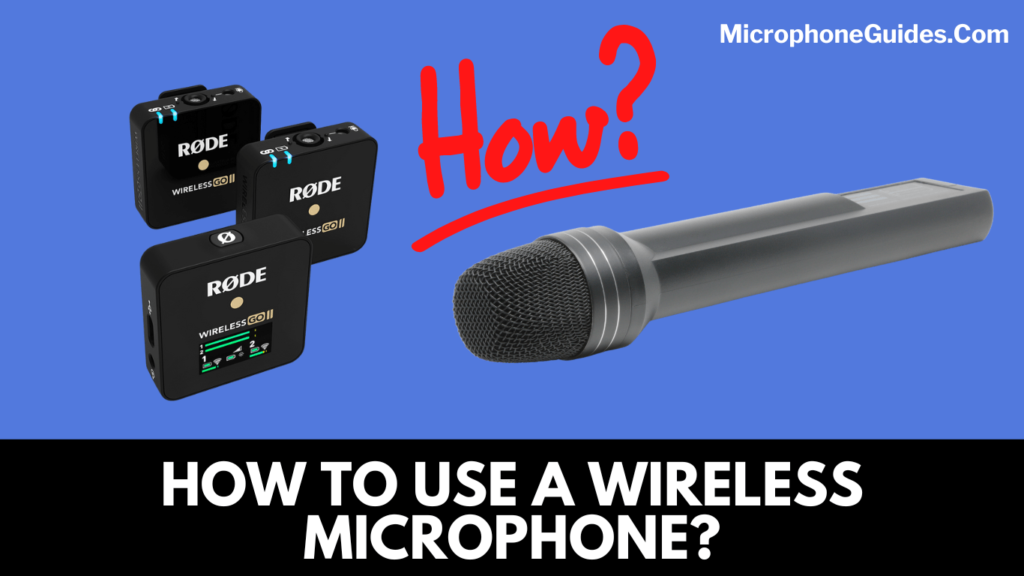Just like other things, communication has also entered the world of modernization. So to support the ever-changing needs, the way of communication is also updated, and that is why the conventional microphones are replaced with wireless microphones.
These microphones are not just popular because of the hassle-free maintenance, but the sound quality generated by these microphones is changing the trends in music, vlogging, broadcasting, and streaming.

So go ahead without wasting a second!
How Do Wireless Microphones System Work?
When you read the physical and technical components of a wireless microphone, you often feel confused, and it might be a daunting task to grab all the concepts of a wireless microphone. But the reality is beyond this misconception. Understanding the working and components of a wireless microphone is quite easier. If you don’t believe this, then read ahead by scrolling the page down!
There are three major components involved in the working of a wireless microphone system and include:
- The Microphone
- The Transmitter
- The Receiver
Let’s discuss them one by one!
- The Microphone
In a wireless microphone system, generally, there could be any of the three microphones, headset, handheld, and the lavalier.
Headset Microphones are the ones that can be worn over the ears on the head. The mic of this system remains close to the mouth of the subject, no matter how noisy the environment is. Moreover, this type of system never lets the user bound to hold the mic all the time as it is already set in the ideal position. The belt pack system of this microphone makes it perfect to use in gatherings.
The second one is the handheld microphone system, which is one of the most typical and the standard type used by almost every person at least once in a lifetime. This is a versatile system that usually uses the conventional type of dynamic or condenser microphones. They have a built-in transmitter which makes them easy to set up.
Last but not least is the lavalier microphone system. This is the most professional microphone that could be attached to the clothing of the subject. The subject does not need to hold it in hand or wear it on the head if it seems ridiculous in some situations. These microphones remain in the closest proximity to the mouth of the subject and record every sound. During the live interviews, you don’t need to fix the on-camera mics because they are the best alternative to those.
Have you ever thought about how the sound is so clear in the film? Even when the camera is placed at a distance? This is the miracle of the lavalier microphone system. These microphones have made video and filmmaking the easiest because they are not visible when attached to the subject.
These mics are connected with the transmitter through a belt pack system that is attached to the subject. The only drawback associated with these mics is their sensitivity because they are highly delicate to run with them.
- The Transmitter
A transmitter, as the name of this jargon suggests, is the component of the microphone system which helps in transmitting one type of signal into another type of signal, i.e.; the audio signals are transferred to the signals that can be easily captured by the receiver.
- The Receiver
The receiver is now ready to pick the signals that are directly coming from the microphone and transmitted by the transmitter. In the case of the digital microphone system, the receiver picks the digital signals and then converts them into audio signals.
This is how the sound travels from the microphone to the receiver and then produces the sound audible to the human ear. This is all about the working of a microphone!
Now have a look at the main types of wireless microphones!
Analogue and Digital Wireless Microphone
Analogue microphones are the type of wireless microphones that work by compressing and expanding the sound signals. First, they compress the signals while picking from the microphone and then expand them again when reaching the receiver, and this process is known as companding.
This helps in maximizing the dynamic range of the signals and minimizing the level of unwanted sound, but it can’t beat breathing which is why not preferred due to this drawback.
Digital wireless microphones have a better frequency response and dynamic range. Moreover, these microphones are power efficient and have extended battery life. These are versatile microphones that can be attached to cameras or mobile phones, which is why they are highly portable and small in size.
Furthermore, these digital wireless microphones are the best way to keep your information safe with the help of encrypted digital signals.
The Uses of Wireless Microphone System
Wireless microphones are an all-rounder microphone system with several uses:
- The on-set sound recording for broadcasting, filmmaking, videography, and streaming is now getting better with these microphones.
- It allows the teachers to move freely to engage the students in the class. Moreover, wireless microphones are the best partners to use during seminars and presentations.
- They are perfect to use during live performances or stage shows.
Last Statement
With the recent changes in the universe and the ever-changing demands of the mass around the world and wireless microphones that are the ultimate key to modern production values are the perfect alternatives to the standard ones. These microphones are more efficient in their working, and knowing how to use a wireless microphone is easier than a typical one. You can also get the one for future use!
William Souza Here, I Am Sound Specialist, Have Trained Many Musicians And Singers. I Write Blog Contents About Sound, Music, Microphone Reviews, Speaker Reviews, Sound Card Reviews And All About Sound/Music Reviews And Instruction. I Am Writing On This Blog MicrophoneGuides.com As On My Experience And Will Update More Information & Review About Different Microphones For Different Users.









